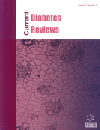- Home
- A-Z Publications
- Current Diabetes Reviews
- Previous Issues
- Volume 6, Issue 1, 2010
Current Diabetes Reviews - Volume 6, Issue 1, 2010
Volume 6, Issue 1, 2010
-
-
UKPDS Risk Engine, Decode and Diabetes PHD Models for the Estimation of Cardiovascular Risk in Patients with Diabetes
More LessIndividuals with type 2 diabetes have a two to four fold increased risk for developing cardiovascular disease than persons without diabetes. The presence of traditional and nontraditional risk factors that frequently coexist with type 2 diabetes are associated with this higher cardiovascular risk. Diabetes itself has been considered a cardiovascular disease equivalent. Nevertheless, the American Diabetes Association has reco Read More
-
-
-
Cystic Fibrosis Related Diabetes Mellitus - Diagnostic and Management Challenges
More LessAuthors: Ngee Lek and Carlo L. AceriniCystic fibrosis (CF) is the commonest autosomal recessive condition among Caucasian populations, affecting 1 in 2500 live births. The median age of survival has dramatically improved and will reach 40 years for children born in the 1990s. Complications such as cystic fibrosis related diabetes mellitus (CFRD) develop with age, and the median age at diagnosis is 21 years. The prevalence of CFRD progressively increases from 9 Read More
-
-
-
Measuring Glycaemic Variation
More LessAuthors: Fergus J. Cameron, Susan M. Donath and Peter A. BaghurstThe measurement of glycaemic variation (GV) is conceived to be of clinical significance in determining diabetes outcomes. The debate as to the importance of GV has been complicated by studies using various meetrics of GV in qualitatively different datasets. The purpose of this review is to discuss the properties of 8 of the more commonly used metrics (M-value, MAGE, “J”-index, CONGA, BG rate of change, ADRR, Lability/HY Read More
-
-
-
The Connection Between C-Reactive Protein (CRP) and Diabetic Vasculopathy. Focus on Preclinical Findings
More LessAuthors: Yves Mugabo, Ling Li and Genevieve RenierCurrent evidence supports a central role of inflammation in the pathogenesis of atherosclerosis and diabetes. Type 2 diabetes is an inflammatory atherothrombotic condition associated with a high prevalence of cardiovascular disease. In patients with type 2 diabetes, low grade inflammation is reflected by increased plasma levels of several biomarkers of inflammation such as C-reactive protein (CRP). Small increases in CRP pre Read More
-
-
-
Emerging Novel Treatment Strategies for Diabetic Eye Diseases
More LessAuthors: Makoto Osanai, Nami Nishikiori, Gang-Hong Lee and Norimasa SawadaEndothelial tight junctions (TJs) in the retina are potential therapeutic targets for diabetic complications such as retinopathy. TJs primarily determine the endothelial barrier, regulating vascular permeability to maintain tightly closed circulating homeostasis. Our recent study has demonstrated that glial cell-derived cytokines limit vascular permeability by modulating the TJ function of retinal capillary endothelium and eventually atten Read More
-
-
-
Advanced Diabetes Care: Three Levels of Prediction, Prevention & Personalized Treatment
More LessThe worldwide epidemic scale of Diabetes mellitus (DM) has been underestimated for a long time. Currently every 10 seconds one patient dies of diabetes-related pathologies. Given the high risk and prevalence of secondary complications as well as individual predisposition to target organ injury, DM is one of the best examples for the application of predictive diagnostics aimed at preventive measures and personalized treat Read More
-
-
-
Zinc, Alpha Cells and Glucagon Secretion
More LessAuthors: Laerke Egefjord, Andreas B. Petersen, Ann M. Bak and Jorgen RungbyZinc concentrates in islet cells and is related to insulin secretion. Islet cells act as a unit within islets and hormone secretion in the islets is profoundly influenced by paracrine and autocrine regulation. Zinc has been recognised as a candidate paracrine inhibitor of glucagon secretion in α-cells. Further zinc fluxes may contribute to regulation of cell mass, Zn2+ may be cytotoxic and Zn2+ depletion by itself can cause cell Read More
-
Volumes & issues
-
Volume 21 (2025)
-
Volume 20 (2024)
-
Volume 19 (2023)
-
Volume 18 (2022)
-
Volume 17 (2021)
-
Volume 16 (2020)
-
Volume 15 (2019)
-
Volume 14 (2018)
-
Volume 13 (2017)
-
Volume 12 (2016)
-
Volume 11 (2015)
-
Volume 10 (2014)
-
Volume 9 (2013)
-
Volume 8 (2012)
-
Volume 7 (2011)
-
Volume 6 (2010)
-
Volume 5 (2009)
-
Volume 4 (2008)
-
Volume 3 (2007)
-
Volume 2 (2006)
-
Volume 1 (2005)
Most Read This Month
Article
content/journals/cdr
Journal
10
5
false
en


